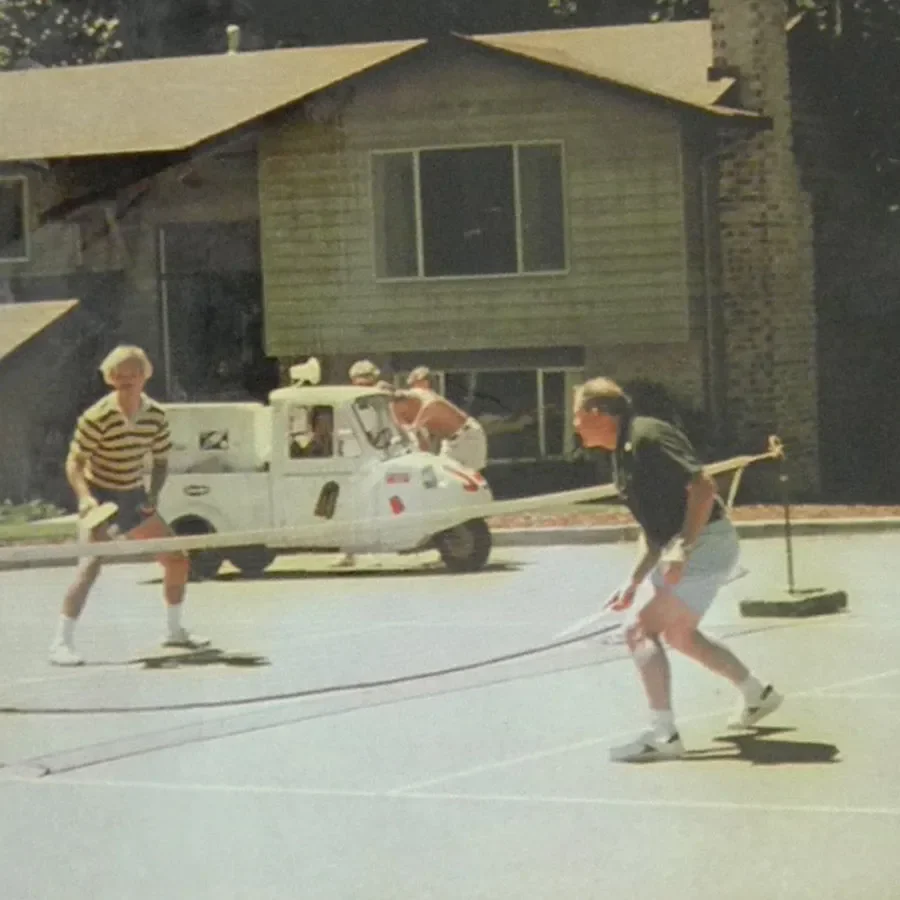A Fun, Friendly History of Pickleball: How a Backyard Experiment Became the Fastest-Growing Sport in America
If you’ve ever stepped onto a pickleball court and wondered, “Okay… but who came up with this delightfully addictive sport?”—you’re not alone. We love a good story almost as much as we love a solid third shot drop—and pickleball’s origin story is the perfect mix of charming, quirky, and completely on-brand for a sport built around community.
So today, we’re going back—way back—to the moment pickleball went from an improvised family pastime on a summer afternoon to the global movement packing parks, rec centers, and tournaments around the world. From its creation to its very questionable name, pickleball’s history explains exactly why the sport is so addicting.
Let’s rewind the tape.
A Summer Afternoon That Changed Everything
A vintage pickleball throwback: Barney McCallum, his son, and friends play in a Seattle-area cul-de-sac in the early 1970s.
Photo courtesy of Pickleball Hall of Fame
Pickleball was born in the summer of 1965 on Bainbridge Island, Washington, when congressman Joel Pritchard and his friends Bill Bell and Barney McCallum were just trying to cure a bout of family boredom. Their kids needed something to do, the badminton equipment was missing pieces, and in true parent-on-a-mission fashion, they improvised.
A lowered badminton net.
A wiffle-style ball.
A couple of solid paddles.
And just like that, pickleball was born.
Was it meant to become a real sport? Not at first. But that’s the magic—pickleball didn’t start in a boardroom or a sports lab. It started in a backyard, designed to get everyone playing together.
That spirit never left.
So… Why “Pickleball”? The Name Debate
Pickleball’s name is part of its charm—and something that keeps people talking. You’ve probably heard the two competing origin stories: the ‘pickle boat’ explanation and the ‘Pickles the dog’ tale. While the dog story has mostly been debunked, it still comes up every time the name debate hits the court.
The “Pickle Boat” Theory
Joel Pritchard’s wife, Joan, said the game reminded her of a “pickle boat,” a mix of leftover rowers from leftovers of other crews—a mashup. Since pickleball borrowed pieces from tennis, badminton, and table tennis, the name fit.
The “Dog Named Pickles” Theory
Another popular story claims the sport was named after the family dog, Pickles, who chased the ball around the yard. Cute? Absolutely. True? Probably not—the dog reportedly came later.
Either way, the name stuck. And honestly, would this sport be nearly as lovable if it were called “Paddle-Wiffle-Tennis-Badminton-Ball”? We vote no.
From Backyard Pastime to Organized Sport
Once pickleball took root in the Pritchards’ backyard, things escalated quickly. Here’s a look at some of the sport’s key milestones:
1965: Pickleball was created.
1967: The first permanent pickleball court was built.
1970s: Communities catch on; paddles and balls begin to be manufactured.
1972: “Pickleball, Inc.” is founded to meet rising demand.
1984: The United States Amateur Pickleball Association (USAPA)—the first official governing body—is established.
1984: The first official Pickleball Rulebook is published.
2002: The first national tournament is held in The Villages, Florida.
2010: The International Federation of Pickleball (IFP) is formed.
2015: Pickleball is recognized as America’s fastest-growing sport by the Sports & Fitness Industry Association (SFIA).
2017: The Pickleball Hall of Fame is established.
2022: Washington State declares pickleball the official state sport.
Today: Pickleball has exploded across parks, schools, and rec centers worldwide.
Fans fill the stands at an APP Tour event—a snapshot of pickleball’s explosive growth today.
Photo by The APP
What started as a backyard game quickly evolved into a structured sport with rules, equipment, national tournaments, and international recognition.
Why Pickleball Exploded
Pickleball didn’t just grow—it skyrocketed. Here’s why:
It’s insanely accessible. Anyone can play, regardless of age or skill level. The smaller court and slower pace make it easier to start (and keep going).
It’s social by design. You’re close to your partner and opponents, talking and laughing—it’s the opposite of an isolating workout.
It’s easy to learn but hard to master. The basics come fast, but the strategy keeps you coming back.
It’s fun. Like… really fun. The rallies are satisfying, the pace is addictive, and the community is truly top-tier.
Pickleball Today: A Global Community With Backyard Roots
Fast-forward to today and pickleball is everywhere—parks, rooftops, gyms, country clubs, and pro tournaments. Millions of players around the world are joining the movement every year.
But despite its explosive growth, it’s still true to its roots: welcoming, social, and powered by community. Pickleball brings people together in a way few sports ever have—and that may be the best part of its history.
Final Serve
Pickleball’s history isn’t just about who invented it or when the first court appeared. It’s about connection, family, laughter, and community. It’s about a sport created for everyone—one that proves the best things in life really do start in someone’s backyard.
At Empower Pickleball, that same spirit is what drives us. It’s behind every article, every community spotlight, and every story we share. We’re here to celebrate the joy that started it all on a summer afternoon in 1965.
Game on, pickleball family—the story’s still being written, and we’re glad you’re part of it.



